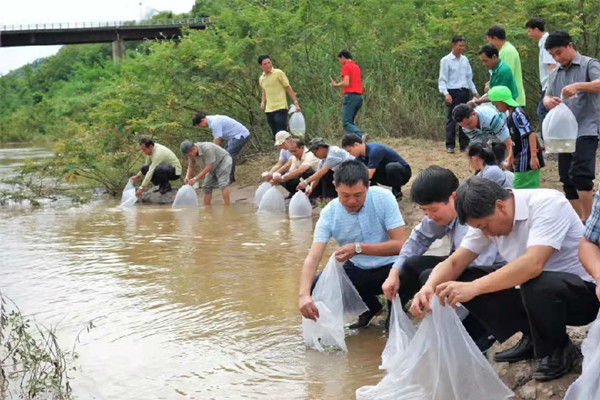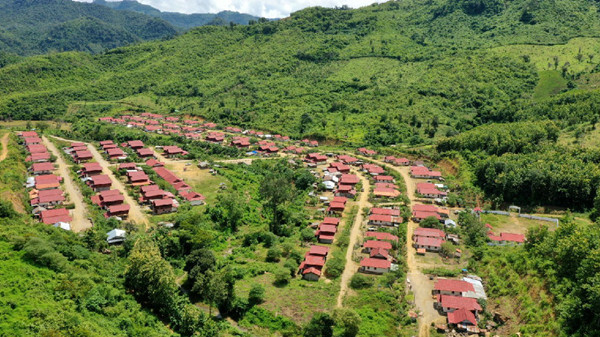Life on both banks of the Nam Ou River in Laos has not been impacted by the dry season. This owes much to Power Construction Corporation of China (POWERCHINA)'s efforts in hydropower construction and environmental protection.
Protecting local environment during construction
Adhering to the principle of green, environmentally-friendly and scientific development, POWERCHINA completed construction of the Nam Ou River Cascade Hydropower Project and also protected and improved local biological diversity over the past 10 years.
When all the cascade hydropower plants went into operation, the environment on banks of the river was pleasant.

A view of a cascade hydropower station over the Nam Ou River in Laos [Photo/sasac.gov.cn]
The largest reach of the Mekong River's left bank in Laos, the Nam Ou River has good water indicators and stretches 475 kilometers throughout the country.
To protect the beautiful sight and the surrounding nature, POWERCHINA made the best use of the water resource and guaranteed joint dispatching function of the basin cascade hydropower stations.
The company also took into consideration the possible displacement of local residents and how to resettle them as well as the occupation of farm lands and forest areas. POWERCHINA was conscious about the impact of the project on ecological environment.
Building a large-scale hydropower station normally needs a large amount of sand and stones. During the peak construction period of the first cascade station, 270 metric tons of sand and stones were needed per hour.
There was no blowing dust or annoying machinery sound, which owes much to the advanced dust and sound reduction equipment and the spraying system.
In addition, POWERCHINA also set up areas to protect rare trees and arranged replantation to guarantee surrounding ecology was unaffected by the construction.
Several animal habitat protection areas have been built to protect local biological diversity. So far, the company has released more than 2 million fries for continuous nine years, becoming the most important Chinese enterprise that participates in local fry releasing activities.
Livelihood projects were also considered during construction. For example, the company planted mango, coconut and jackfruit trees near the fourth cascade station, benefiting local residents.

POWERCHINA employees and local government personnel organize a fry releasing activity along the Nam Ou River in Laos. [Photo/sasac.gov.cn]
Building cascade hydropower stations a hot scenic spot
Embraced by hills, the ancient capital Luang Prabang has been one of the most popular tourist attractions in Laos. Now, people have one more place to go 40 kilometers southwest of the city.
With a water area covering 10 million square meters, the reservoir of the first cascade station over the Nam Ou River has a light grey dam. Banana trees, teakwood and bougainvillea spectabilis are planted around, making the station utterly natural.
The roof of the station's main workshop was painted in red, which hews close to local culture.
Many restaurants and bars have settled down at the reservoir area, attracting people to visit the harmonious sight combining modern hydropower station and the natural scenery.
Benefiting local livelihood
As development and operation of the cascade hydropower station project, environment and livelihood kept improving.
A local resident living near the seventh cascade hydropower station said in the past, local people lived on fishing and hunting. They also set on fire to reclaim farm land in the dry season to plant crops, which greatly damaged the environment.
It was three years ago when the villagers started a new lifestyle by moving into houses with three bedrooms, one living room and one bathroom, which have access to power and drinking water near the seventh cascade station.
That was an immigrant living improvement project launched by POWERCHINA.
Considering local situation, the company cooperated with local government and launched the project based on villagers' opinions.
In addition to new houses, villagers were allocated with farming land nearby and they can also choose to plant commercial crops such as jackfruit, banana, rubber, fructus amomi and sugarcane and feed livestock like cattle, sheep and pigs. Seeds, saplings and cubs as well as production tools are provided by the company and the government.
Agricultural experts are also invited to guide villagers on how to plant and feed.

A bird's-eye view of the immigrant village near the Nam Ou River in Laos [Photo/sasac.gov.cn]
What's more, POWERCHINA built roads to make it easier for villagers to ride between their home and the farm land. A 93-kilometer road was also developed as a supporting project for the seventh cascade hydropower station, which links 13 villages in affected area and provides export channel for locally-produced agricultural products.
So far, all 30 immigrant villages in the Nam Ou River basin have been launched and the immigrant living improvement project focusing on green, environmental protection and efficiency is making new progress. More than 11,000 villagers are welcoming their new life toward prosperity.
(Executive editor: Ma Zheming)